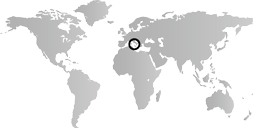The ambitious projects of urban renewal, development, and expansion initiated in Rome in the fifteenth and sixteenth centuries reach a spectacular apex during this period. An affluent and powerful papacy sponsors many of these projects with the aim of fashioning the city into a world capital of great beauty, a hub of learning and the arts, and, above all, a symbol of Catholic glory. Artists from elsewhere in Europe, particularly the North, visit Rome to study the masterpieces of antiquity and the Renaissance and to execute commissions for the popes and a wealthy secular clientele. It is here that the Baroque style takes form, shaped especially by the hands of several great masters: Gian Lorenzo Bernini (1598–1680), Francesco Borromini (1599–1667), and Pietro da Cortona (1596–1669). Monuments of the Baroque join architecture, painting, and sculpture into a unified whole of extraordinary grandeur.
Possession of territories in Southern Italy is, as in the last period, widely contested by various foreign powers. Many artists from the Iberian Peninsula are drawn to this region, particularly to Naples, a city under Spanish rule. A school of painting flourishes there, profoundly influenced by Caravaggio (1571–1610). Notable examples of Baroque architecture occur throughout Southern Italy, particularly in the Sicilian cities of Noto, Ragusa, and Modica, rebuilt after a devastating earthquake in 1693. Southern Italy is also an important center of porcelain production.


